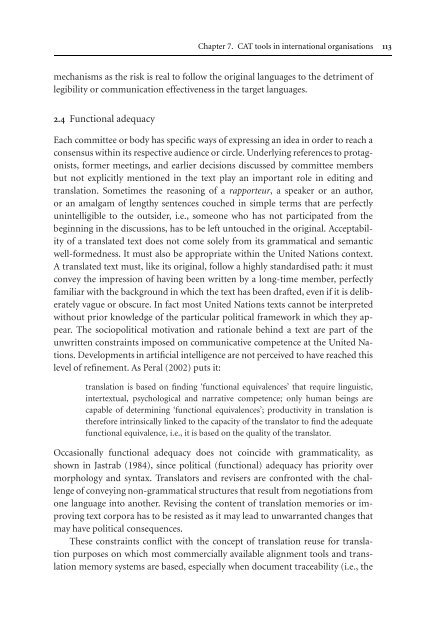Topics in Language Resources for Translation ... - ymerleksi - home
Topics in Language Resources for Translation ... - ymerleksi - home
Topics in Language Resources for Translation ... - ymerleksi - home
- No tags were found...
You also want an ePaper? Increase the reach of your titles
YUMPU automatically turns print PDFs into web optimized ePapers that Google loves.
Chapter 7. CAT tools <strong>in</strong> <strong>in</strong>ternational organisations 113mechanisms as the risk is real to follow the orig<strong>in</strong>al languages to the detriment oflegibility or communication effectiveness <strong>in</strong> the target languages.2.4 Functional adequacyEach committee or body has specific ways of express<strong>in</strong>g an idea <strong>in</strong> order to reach aconsensus with<strong>in</strong> its respective audience or circle. Underly<strong>in</strong>g references to protagonists,<strong>for</strong>mer meet<strong>in</strong>gs, and earlier decisions discussed by committee membersbut not explicitly mentioned <strong>in</strong> the text play an important role <strong>in</strong> edit<strong>in</strong>g andtranslation. Sometimes the reason<strong>in</strong>g of a rapporteur, aspeakeroranauthor,or an amalgam of lengthy sentences couched <strong>in</strong> simple terms that are perfectlyun<strong>in</strong>telligible to the outsider, i.e., someone who has not participated from thebeg<strong>in</strong>n<strong>in</strong>g <strong>in</strong> the discussions, has to be left untouched <strong>in</strong> the orig<strong>in</strong>al. Acceptabilityof a translated text does not come solely from its grammatical and semanticwell-<strong>for</strong>medness. It must also be appropriate with<strong>in</strong> the United Nations context.A translated text must, like its orig<strong>in</strong>al, follow a highly standardised path: it mustconvey the impression of hav<strong>in</strong>g been written by a long-time member, perfectlyfamiliar with the background <strong>in</strong> which the text has been drafted, even if it is deliberatelyvague or obscure. In fact most United Nations texts cannot be <strong>in</strong>terpretedwithout prior knowledge of the particular political framework <strong>in</strong> which they appear.The sociopolitical motivation and rationale beh<strong>in</strong>d a text are part of theunwritten constra<strong>in</strong>ts imposed on communicative competence at the United Nations.Developments <strong>in</strong> artificial <strong>in</strong>telligence are not perceived to have reached thislevel of ref<strong>in</strong>ement. As Peral (2002) puts it:translation is based on f<strong>in</strong>d<strong>in</strong>g ‘functional equivalences’ that require l<strong>in</strong>guistic,<strong>in</strong>tertextual, psychological and narrative competence; only human be<strong>in</strong>gs arecapable of determ<strong>in</strong><strong>in</strong>g ‘functional equivalences’; productivity <strong>in</strong> translation isthere<strong>for</strong>e <strong>in</strong>tr<strong>in</strong>sically l<strong>in</strong>ked to the capacity of the translator to f<strong>in</strong>d the adequatefunctional equivalence, i.e., it is based on the quality of the translator.Occasionally functional adequacy does not co<strong>in</strong>cide with grammaticality, asshown <strong>in</strong> Jastrab (1984), s<strong>in</strong>ce political (functional) adequacy has priority overmorphology and syntax. Translators and revisers are confronted with the challengeof convey<strong>in</strong>g non-grammatical structures that result from negotiations fromone language <strong>in</strong>to another. Revis<strong>in</strong>g the content of translation memories or improv<strong>in</strong>gtextcorporahastoberesistedasitmayleadtounwarrantedchangesthatmay have political consequences.These constra<strong>in</strong>ts conflict with the concept of translation reuse <strong>for</strong> translationpurposes on which most commercially available alignment tools and translationmemory systems are based, especially when document traceability (i.e., the
















